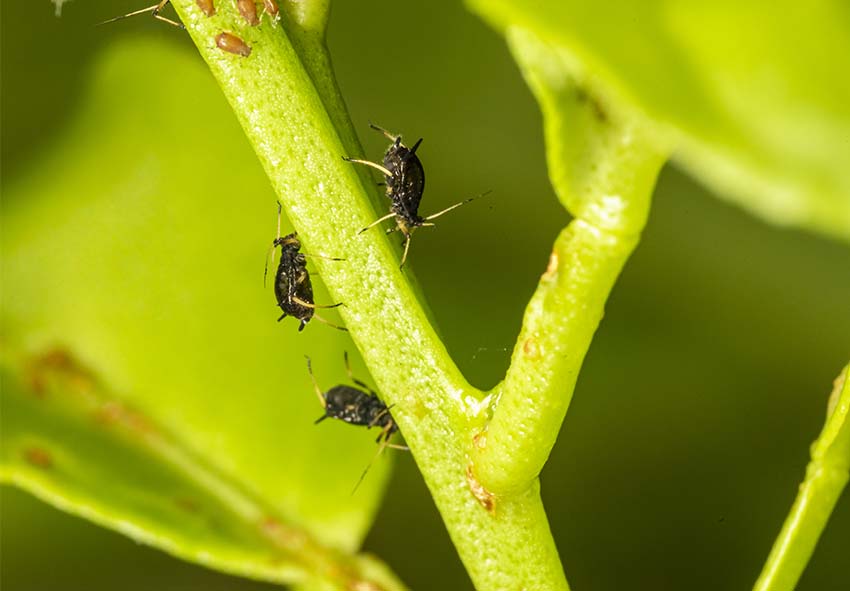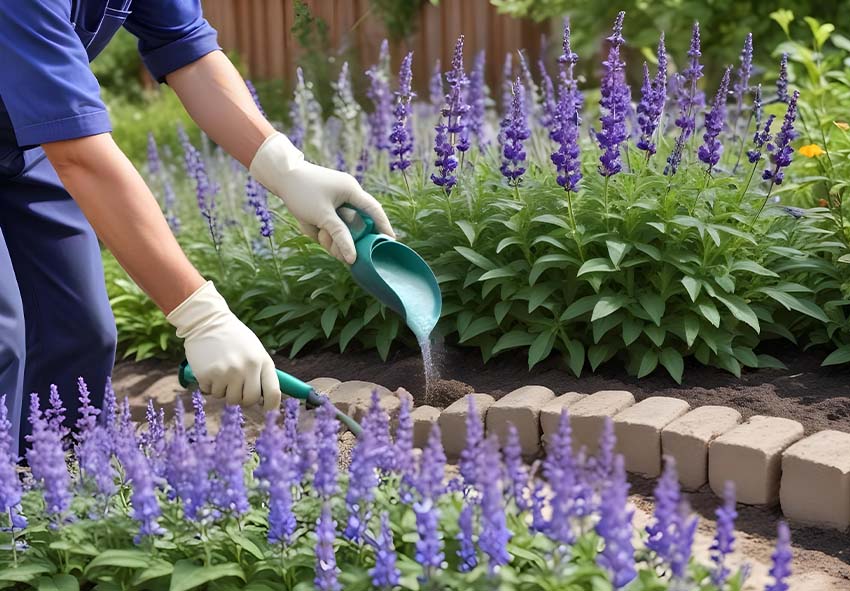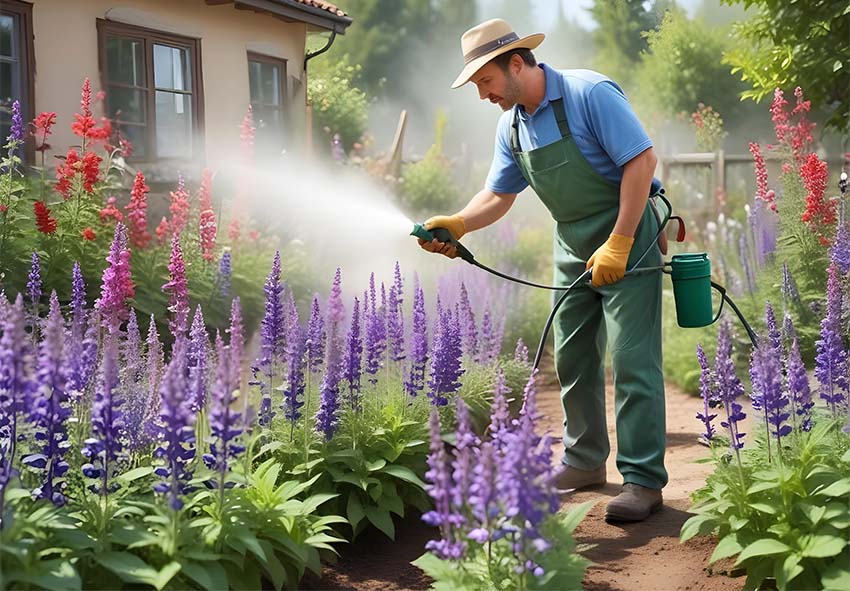Salvia, commonly known as sage, is a versatile and popular plant in many gardens, appreciated for its vibrant flowers and aromatic foliage. With over 900 species, Salvia can enhance any garden setting, whether you’re looking for striking color or fragrant herbs. However, like any garden plant, Salvia is susceptible to various pests that can damage its health and appearance. Effective pest control is crucial to maintaining the vigor and beauty of your Salvia plants, ensuring they thrive throughout the growing season. Our gardening blog is a perfect place to find all the information you need!
Common Pests That Affect Salvia

Salvia plants can fall victim to several common garden pests. Identifying these pests early and understanding their behavior is the first step in protecting your plants.
Aphids
Aphids are small, pear-shaped insects that feed on the sap of Salvia plants, weakening them and causing distorted growth. They often cluster on the undersides of leaves and can be green, black, or brown. If your Salvia has curling leaves or sticky honeydew deposits, it’s likely infested with aphids. These pests can also attract ants and lead to the development of sooty mold on the plant’s surface.
Spider Mites
Spider mites are tiny, spider-like arachnids that thrive in hot, dry conditions. They feed on Salvia by piercing plant cells and sucking out the contents, which leads to stippled, yellowing leaves. A telltale sign of spider mites is the presence of fine webbing on the undersides of leaves. If left unchecked, spider mites can cause significant damage to Salvia, including leaf drop and stunted growth.
Whiteflies
Whiteflies are small, white-winged insects that hover around Salvia plants when disturbed. These pests feed on the plant’s sap, leading to weakened growth and yellowed leaves. Infestations often result in the production of honeydew, which can attract ants and promote the growth of sooty mold. Whiteflies reproduce quickly, making early detection and control crucial.
Slugs and Snails
Slugs and snails are common garden pests that can wreak havoc on Salvia plants, particularly in damp conditions. They feed on the leaves, leaving large, irregular holes and slime trails behind. Young Salvia plants are especially vulnerable to slug and snail damage, which can stunt their growth or even kill them if the infestation is severe.
Caterpillars
Caterpillars, the larval stage of butterflies and moths, are another group of pests that can damage Salvia. Certain species, like the cabbage looper or tobacco budworm, are particularly fond of Salvia leaves and flowers. These pests are easy to spot, as they chew large holes in the foliage, often leaving the edges ragged. Caterpillars can defoliate a Salvia plant if not controlled early.
Organic Pest Control Solutions for Salvia

To keep your Salvia healthy, it’s important to use pest control methods that are effective yet gentle on the environment. Organic solutions are ideal, as they minimize harm to beneficial insects and the surrounding ecosystem. We have already summarised these methods in our full guide for Salvia. You can also find more detailed information here.
Natural Predators
Encouraging natural predators is a highly effective way to control pests on Salvia:
- Ladybugs:
Ladybugs are excellent natural predators of aphids, which are common pests on Salvia. By introducing or attracting ladybugs to your garden, you can effectively reduce aphid populations and protect your plants.
- Predatory Mites:
Predatory mites feed on spider mites, helping to control these damaging pests on Salvia. These beneficial mites can be introduced into your garden or greenhouse to keep spider mite infestations in check.
- Birds:
Birds such as wrens and chickadees are natural predators of caterpillars and other insects that can harm Salvia plants. Attracting these birds with feeders or nesting boxes can help maintain a healthy balance in your garden ecosystem.
- Hoverflies:
Hoverflies, also known as syrphid flies, are beneficial insects whose larvae consume large quantities of aphids and other small pests. By planting nectar-rich flowers, you can attract hoverflies to your garden.
- Lacewings:
Lacewing larvae, often called “aphid lions,” are voracious predators of aphids, whiteflies, and other soft-bodied insects. Encouraging lacewings in your garden can provide natural pest control, reducing the need for chemical treatments.
Homemade Remedies
Homemade remedies are another great option for managing pests organically. A simple soap and water spray can help dislodge and kill aphids and spider mites. Neem oil, derived from the neem tree, is a powerful natural insecticide that works against a variety of pests, including whiteflies and caterpillars. Garlic or chili sprays can also deter pests with their strong odors, providing an easy and effective way to protect your Salvia.
Biological Controls
Biological controls involve using living organisms to control pest populations. Beneficial nematodes, for example, can be introduced into the soil to target pests like slugs and caterpillars. For caterpillar control, Bacillus thuringiensis (Bt) is a naturally occurring bacterium that specifically targets caterpillars, effectively reducing their numbers without harming other beneficial insects.
Physical Barriers and Traps
Physical barriers and traps can provide effective protection for your Salvia plants. Insect netting can prevent pests like whiteflies from reaching the plants, while sticky traps are useful for capturing flying insects. For slugs and snails, copper tape placed around the base of plants can deter them, and beer traps can be used to attract and drown these pests.
Companion Planting
Companion planting is a proactive way to deter pests from Salvia by planting species that repel harmful insects and different diseases:
- Marigolds: Planting marigolds near Salvia can help repel aphids and other harmful insects, providing natural pest protection.
- Garlic: Garlic can deter a variety of pests, including aphids and spider mites, making it a great companion plant for Salvia.
- Onions: Onions help repel many common garden pests and can be planted alongside Salvia to enhance its natural defenses.
Dealing with Severe Infestations

Sometimes, despite your best efforts, pest infestations can become severe and require stronger interventions.
When to Consider Chemical Treatments
If organic methods fail to control a severe infestation, it may be necessary to consider chemical treatments. Choose low-toxicity options that are specifically labeled for use on Salvia and pose minimal risk to beneficial insects and the environment. Always opt for targeted applications to reduce the impact on non-target species.
Safe Application Practices
When applying chemical treatments, it’s crucial to follow safe practices. Apply treatments during the early morning or late evening when pollinators are less active. Always wear protective gear and avoid spraying on windy days to prevent drift. Additionally, consider spot-treating the affected areas rather than applying chemicals broadly across the entire plant or garden.
Long-Term Care and Pest Prevention
To keep your Salvia plants healthy and pest-free, long-term care and preventive measures are essential.
Seasonal Maintenance
Regular seasonal maintenance is key to preventing pest issues before they start:
Spring:
- Inspect for New Growth: Check Salvia plants for signs of new growth and remove any dead or damaged stems.
- Early Pest Monitoring: Begin monitoring for early signs of pest infestations like aphids or spider mites and address them promptly with organic solutions.
Summer:
- Regular Watering: Ensure consistent watering to prevent stress on the plants, which can make them more susceptible to pests.
- Mulching: Apply mulch to retain moisture and suppress weeds that can harbor pests.
Fall:
- Prune Back Plants: Cut back Salvia plants to promote healthy growth the following season and reduce overwintering sites for pests.
- Clean Up Debris: Remove fallen leaves and plant debris around Salvia to prevent pests from taking shelter over winter.
Winter:
- Protect from Cold: Mulch heavily around Salvia to protect the roots from freezing temperatures.
- Prepare for Spring: Plan crop rotation and order pest-resistant Salvia varieties for the upcoming growing season.
Rotating Crops and Varieties
Rotating the location of your Salvia plants each year can help reduce the buildup of pests in the soil. Additionally, consider planting pest-resistant varieties of Salvia, which are less likely to suffer from common pest problems. This practice can significantly reduce the likelihood of severe infestations and promote the long-term health of your garden.
Conclusion
Effective pest control is crucial for maintaining the health and beauty of your Salvia plants. By understanding common pests, using organic control methods, and implementing preventive strategies, you can ensure your Salvia thrives in your garden. Remember, a healthy garden is a balanced one, where beneficial insects and plants work together to keep pests at bay.
Frequently Asked Questions (FAQs) about Salvia Pest Control
1. What are the most common pests that affect Salvia plants?
The most common pests affecting Salvia include aphids, spider mites, whiteflies, slugs, snails, and caterpillars. These pests can cause damage by feeding on the plant’s leaves, stems, and flowers, leading to stunted growth, discolored foliage, and reduced flowering. Regular monitoring and early intervention are key to managing these pests.
2. Are there any organic methods to control spider mites on Salvia?
Yes, organic methods to control spider mites on Salvia include introducing predatory mites, which feed on spider mites. You can also use neem oil or a soap and water spray to treat infestations. Maintaining adequate humidity around the plants and avoiding water stress can also help prevent spider mite outbreaks.
3. What should I do if my Salvia plants are infested with whiteflies?
If your Salvia plants are infested with whiteflies, you can use yellow sticky traps to catch the adults. A neem oil spray can be applied to control both the adults and their larvae. Additionally, encouraging natural predators like ladybugs and lacewings can help reduce whitefly populations.
4. Can companion planting help in controlling pests on Salvia?
Yes, companion planting can be an effective way to control pests on Salvia. Planting marigolds, garlic, or onions near Salvia can help repel common pests like aphids, spider mites, and whiteflies. These companion plants release natural chemicals that deter pests, reducing the need for chemical treatments.
5. Can I order dutch Salvia from your online store?
Yes, we offer a wide selection of Salvia, including some varieties originating from Holland, renowned for their quality and beauty. Our online store Dutch-bulbs.com features a diverse range of Salvia. Explore our collection to find the perfect variety for your garden or landscaping projects.
Published: 06.09.2024
